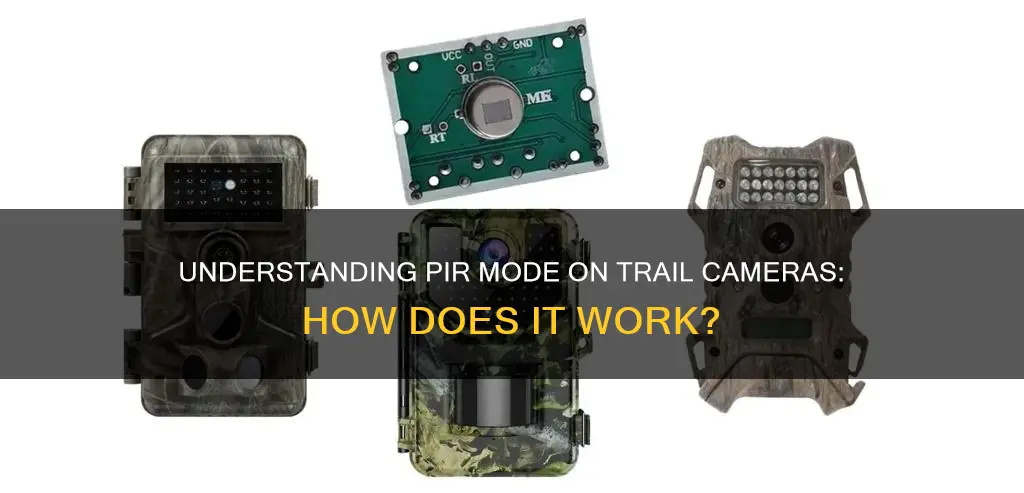
Trail or game cameras are remote cameras that remain in an electronic sleep state until their motion sensors detect movement, at which point they are activated and their shutters triggered to capture images or record videos. One of the functions of trail cameras is PIR mode, which stands for passive infrared. When PIR mode is activated, the camera only takes a photo when the PIR sensor is activated. Passive infrared sensors detect the motion of objects in its line of view by measuring the infrared light emitted by or reflected off these objects.
| Characteristics | Values |
|---|---|
| PIR Full Form | Passive Infrared |
| PIR Function | Detects motion and triggers the camera to capture images or record videos |
| PIR Technology | Passive Infrared (PIR) |
| PIR vs AIR | PIR is different from Active Infrared (AIR) as it receives information about motion and temperature |
| PIR Activation | Activated when there is a change in the amount of infrared radiation interfering with it |
| PIR and Temperature | PIR is triggered when there is a change in temperature |
| PIR and Surface Properties | PIR activation depends on the temperature and surface properties of the object in front of the PIR sensor |
| PIR and Animals | PIR can detect animals as they emit infrared radiation |
| PIR and Cars | PIR can detect cars as they emit a high amount of heat |
| PIR and Fire | PIR can be used to detect fire |
| PIR and Glass | PIR does not work through glass |
| PIR Angle | PIR Angle refers to the degree that the camera can sense movement |
| PIR Interval | Refers to the time interval between subsequent camera triggers |
What You'll Learn
- PIR mode is a feature that, when activated, takes a photo only when the PIR sensor detects motion
- PIR stands for passive infrared, and PIR Angle refers to the degree that the camera can sense movement
- PIR sensors work best when detecting right-angle movements
- PIR sensors detect a change in the amount of infrared radiation interfering with it
- PIR mode can be activated by going to the 'menu' option and selecting 'Trigger'

PIR mode is a feature that, when activated, takes a photo only when the PIR sensor detects motion
PIR mode is a feature of trail cameras that, when activated, takes a photo only when the PIR sensor detects motion. PIR stands for passive infrared, and these sensors detect motion by measuring the infrared light emitted or reflected by objects in their line of sight.
PIR sensors are an essential component of trail cameras, and they work by detecting changes in infrared radiation. When an object moves in front of the sensor, the amount of infrared radiation detected by the sensor changes, which triggers the camera to take a picture. This is different from active infrared (AIR) technology, where a beam of infrared light is emitted and the camera is triggered when the beam is broken.
The PIR mode on a trail camera helps the camera work more effectively by detecting motion based on sudden temperature changes. This can be useful for monitoring wildlife, security, or other remote camera applications.
The detection angle and distance of the PIR sensor are important specifications that determine the range and angle at which the camera can detect motion. The detection angle can be affected by the Fresnel lens design, while the distance is dependent on the sensitivity and circuitry of the PIR sensor.
It's worth noting that PIR sensors do have some limitations. For example, they may not work through glass, especially insulated glass or newer windows that are designed to block infrared radiation. Additionally, PIR sensors may not detect very slow movement or objects that are very close to the sensor but motionless.
By understanding how PIR mode works and the specifications of the PIR sensor, users can optimise their trail camera setup to capture the desired images effectively.
Charging SimpliSafe Camera Batteries: A Step-by-Step Guide
You may want to see also

PIR stands for passive infrared, and PIR Angle refers to the degree that the camera can sense movement
PIR stands for Passive Infrared Sensor, and it is the cornerstone of any trail camera's detection circuit. The sensor detects motion and heat by sensing the infrared radiation emitted or reflected by objects, which then causes a trigger event. The sensor is typically housed in a metallic case that is mounted to the camera's printed circuit board. The sensor elements are made of a material sensitive to infrared radiation and are placed behind optical filters or "windows" that allow the sensor to see a specified distance, known as the detection distance.
The PIR Angle, or detection angle, refers to the degree or angle that the camera can sense movement. This is influenced by the design of the Fresnel lens, which is the small black curved piece of plastic on the camera that works with the PIR sensor to complete the detection system. The Fresnel lens condenses light, providing a larger range of infrared radiation to the sensor, and divides the detection area into broader zones. The design and layout of the Fresnel lens are important to the angle and zones of the camera's detection ability.
Cameras with a large PIR Angle can detect movement faster and are more likely to capture the subject in the center of the frame. High-quality cameras usually have a PIR Angle of 48 degrees, allowing them to capture images of almost everything that passes within their field of view, even if the animals are moving quickly.
On the other hand, cameras with a narrow PIR Angle (10 degrees or less) tend to have a longer detection range but may only capture images of animals when they are in the middle of the frame. This can result in photos with half of an animal in the frame or empty photos if the animal wanders into the camera's field of view but not the detection zone.
Extending Black Magic Camera Battery Life: Top Tips
You may want to see also

PIR sensors work best when detecting right-angle movements
PIR stands for Passive Infrared. PIR sensors are electronic sensors that measure infrared (IR) light radiating from objects in their field of view. They are most often used in PIR-based motion detectors. They are commonly used in security alarms and automatic lighting applications.
PIR sensors are more complicated than many other sensors because multiple variables affect their input and output. The PIR sensor itself has two slots, each made of a special material that is sensitive to IR. When the sensor is idle, both slots detect the same amount of IR from the surrounding environment. When a warm body like a human or animal passes by, it first intercepts one half of the PIR sensor, which causes a positive differential change between the two halves. When the warm body leaves the sensing area, the reverse happens, and the sensor generates a negative differential change. These change pulses are what is detected.
PIR Angle refers to the degree that the camera can sense movement. Cameras with a large PIR Angle can detect movement faster and have a better chance of capturing the subject in the center of the frame. High-quality cameras usually carry a PIR Angle of 48 degrees and can capture images of almost everything that passes within their field of view, including animals moving quickly through the frame.
Charging Your Kodak Camera Battery: How Long Does It Take?
You may want to see also

PIR sensors detect a change in the amount of infrared radiation interfering with it
PIR stands for Passive Infrared, and PIR Angle refers to the degree that a trail camera can sense movement. Trail cameras are designed to exist in a state of almost complete electronic sleep, much like a TV on standby. The motion sensor is what is fully awake and in most trail cameras, this is a PIR detector. When the PIR detects motion, it triggers a rapid chain of events: light levels are detected, focus is achieved, shutter speed is determined, and one or more pictures or videos are taken by the image sensor.
PIR sensors detect a change in the amount of infrared radiation interfering with them. PIR sensors detect general movement but do not give information on who or what moved; for that purpose, an imaging IR sensor is required. PIR sensors contain an infrared radiation sensing element and are typically housed in a metallic case that is mounted to the camera's printed circuit board. The sensor elements are made of a material sensitive to infrared radiation and are placed behind optical filters or "windows" that allow the sensor to see a specified distance, commonly known as the detection distance.
The amount of IR detected through each window by the element, which is balanced equally, is considered the relative or ambient IR. When the sensor detects equal amounts of IR, the camera remains inactive. Trigger events occur when the sensor is able to detect a change in the relative IR from one element to another, caused by motion and heat, also known as dynamic IR.
PIR sensors are most often used in PIR-based motion detectors, such as security alarms and automatic lighting applications.
Understanding Drive Mode in Action Cameras
You may want to see also

PIR mode can be activated by going to the 'menu' option and selecting 'Trigger'
PIR mode, or Passive Infrared mode, is a feature on trail cameras that helps the camera work more effectively. It can be activated by going to the 'menu' option and selecting 'Trigger'. Once activated, the PIR mode will take a photo only when the PIR sensor detects motion.
PIR mode is particularly useful for detecting animals, as it measures the light or heat emanating from an object, person, or animal in its line of sight. This is done by detecting radiant heat generated or reflected by objects. Every object with a temperature above absolute zero emits heat in the form of radiation, which is usually invisible to the human eye as it falls within the infrared wavelength.
The PIR mode will not tell you what moved past its line of sight unless it is triggered and snapshots are taken. This is where the trail camera's capture mode comes into play. The camera can be set to capture still images or video recordings. Still images are great, but video recordings allow the user to glimpse into the world of the animal and watch its behaviour, which can reveal more information than a single frozen image.
The PIR Angle refers to the degree that the camera can sense movement. Cameras with a large PIR Angle can detect movement faster and have a better chance of capturing the subject in the centre of the frame, rather than at the edges. High-quality cameras usually carry a PIR Angle of 48 degrees, allowing them to capture almost everything that passes within their field of view.
It is important to note that PIR mode can be activated for either 24 hours, during the day, or at night. This flexibility allows users to customise their camera settings according to their specific needs and the behaviour of their target subjects.
Numbering Images in Camera Raw: A Beginner's Guide
You may want to see also
Frequently asked questions
PIR stands for Passive Infrared.
PIR detects motion and changes in temperature to activate the camera. It measures the light or heat emanating from an object, person, or animal in its line of sight.
PIR sensors are triggered by a change in the amount of infrared radiation interfering with it. This can be caused by a change in temperature or by objects with different surface qualities moving in front of the sensor.
PIR mode is a feature that, when activated, takes a photo only when the PIR sensor is triggered.
The PIR interval refers to the time interval between subsequent camera triggers, or the "retrigger time". It is the time that passes before the camera can be triggered again after taking a picture or video.







